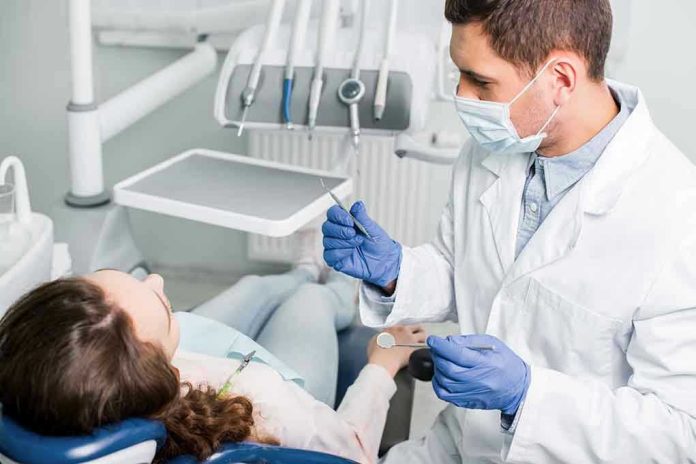
If you think your morning coffee breath is a crime against humanity, you haven’t met the arsenal of solutions that can freshen even the most catastrophic halitosis—science and reviews agree, your social life can be saved.
At a Glance
- Bad breath (halitosis) has plagued humanity since ancient times and still haunts more than half of us today.
- True rescue comes from a combination of mechanical cleaning, targeted products, and sometimes medical sleuthing—not just minty cover-ups.
- Today’s evidence-backed solutions include tongue scrapers, probiotics, and specialized mouthwashes, all endorsed by dentists.
- Persistent bad breath often signals deeper health issues, making professional evaluation crucial for lasting relief.
Behind the Stench: A History of Halitosis and Human Desperation
Centuries before the first awkward office close-talkers, ancient civilizations were waging war on foul breath. Halitosis, the medical term for bad breath, is not just a modern embarrassment. References to stinky breath pepper old medical texts and ancient remedies, from chewing on aromatic tree resin in Egypt to swishing herbal rinses in medieval Europe. Yet, despite our obsession with minty freshness, the real culprit is the same as ever: bacteria in our mouths, feasting on leftover food and belching out volatile sulfur compounds—think rotten eggs but trapped in your mouth. The revolution began in the 20th century with the birth of mass-market toothpaste and mouthwash, but only in recent decades have we truly understood the microbiome underworld that rules our oral odor[4].
As oral hygiene awareness skyrocketed in the late 20th and early 21st centuries, so did the parade of products promising to make your mouth a social safe zone. From the first tongue scrapers that looked suspiciously like medieval torture devices, to probiotic rinses that sound more like yogurt than toothpaste, we’ve entered a golden age of halitosis-fighting innovation. And thanks to COVID-era mask-wearing, millions had no choice but to marinate in their own breath—sparking a global surge in self-awareness and product sales[2][3][4].
The Players: Who’s Really Winning the Breath Wars?
No one wants to be the person with “that” breath, but the battle lines are drawn. Consumers, desperate for social acceptance and a whiff of dignity, will try just about anything. Dental professionals have seized the moment, dishing out guidance (and sometimes products) with the authority of modern-day oracles. Then there are the oral care giants—think Listerine, Colgate, and TheraBreath—who churn out solutions faster than you can say “chlorhexidine.” Toss in retailers and media powerhouses curating “top 11” lists, and you’ve got a market driven by anxiety, hope, and a dash of science.
But let’s not forget the researchers, quietly mapping the complex web of bacteria and body chemistry that drives halitosis. Their findings filter down, shaping products, professional advice, and even the language we use to talk about bad breath. Ultimately, it’s the American Dental Association, the FDA, and those trusted household brands that steer the ship—but the consumer holds the compass, voting with their dollars and reviews[1][2][3].
The New Science of Fresh Breath: What Works, What’s Hype
The era of simply masking odor with a mint is over. Modern dental wisdom now calls for a multi-pronged attack: brush and floss with military precision, scrape your tongue like you mean it, rinse with a product that targets those sulfur-spewing bacteria, and—if you dare—dabble in probiotics. The reviews are in: some of the hottest solutions include stainless steel tongue scrapers (for that deep clean), alcohol-free antibacterial rinses, and mouthwashes with active oxygen or zinc compounds. Dentists warn: if you’re skipping your tongue or letting dry mouth set in, you’re practically inviting disaster[1][3][4].
Mouthwashes that promise to kill 99% of germs might sound impressive, but experts say the real trick is consistency—and knowing when to seek medical help. Chronic halitosis, especially when resistant to even the most heroic hygiene routines, can signal deeper health issues like diabetes, GERD, or even liver disease. That’s why leading clinics like Mayo and Harvard say: don’t ignore persistent stink; get it checked out[1][3][4].
Impact and the Road Ahead: From Social Horror to Medical Insight
Short-term, every successful breath rescue means a happier, more confident person—and a cash register ringing somewhere. But the stakes are higher than just social survival. Improved oral hygiene can mean fewer cavities, less gum disease, and even lower risk for systemic diseases long-term. For the oral care industry, the scent of opportunity is sweet: consumer demand for premium, evidence-backed products is driving innovation and fierce competition.
Socially, the days of quietly suffering in shame are fading. With better education and a flood of new options, more people are seeking real solutions—and demanding transparency from brands and professionals alike. If public health campaigns have their way, the stigma around bad breath could finally start to lift, replaced by a focus on root causes and real prevention. In the end, the war on halitosis is a battle of science, savvy marketing, and good old-fashioned common sense[2][3][4].
Sources:
Peer-reviewed narrative review (PMC)







